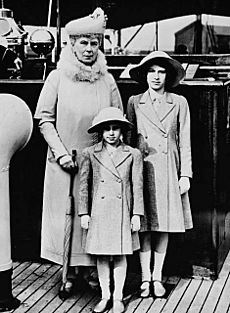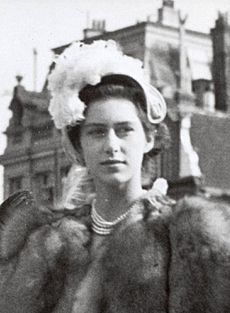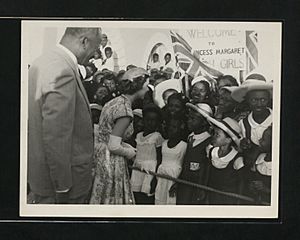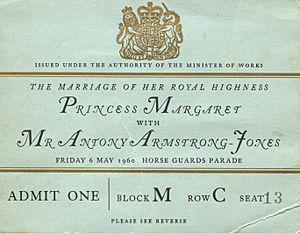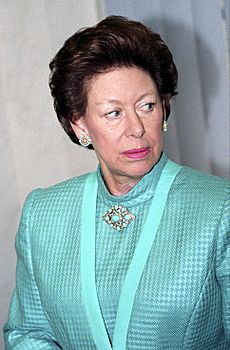Princess Margaret, Countess of Snowdon facts for kids
Quick facts for kids Princess Margaret |
|
|---|---|
| Countess of Snowdon | |
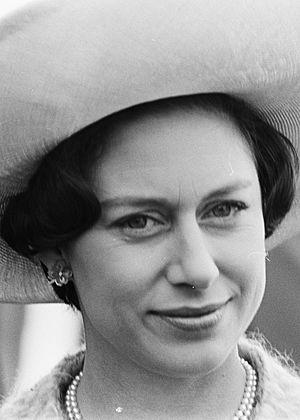
Margaret in 1965
|
|
| Born | Princess Margaret Rose of York 21 August 1930 Glamis Castle, Angus, Scotland |
| Died | 9 February 2002 (aged 71) King Edward VII's Hospital, London, England |
| Burial | 15 February 2002 Ashes placed in the Royal Vault, St George's Chapel
9 April 2002Ashes interred in the King George VI Memorial Chapel, St George's Chapel
|
| Spouse | |
| Issue | |
| House | Windsor |
| Father | George VI |
| Mother | Elizabeth Bowes-Lyon |
| Signature |  |
Princess Margaret, Countess of Snowdon (born Margaret Rose; 21 August 1930 – 9 February 2002) was the younger daughter of King George VI and Queen Elizabeth The Queen Mother. She was also the only sister of Queen Elizabeth II.
Margaret was born when her parents were the Duke and Duchess of York. She spent most of her childhood with them and her older sister. Her life changed when she was six years old. Her father became king after his brother Edward VIII gave up the throne. Margaret's sister became the next in line to the throne, and Margaret was second. Her place in the line of succession changed over the years as Elizabeth's children and grandchildren were born. During World War II, the two sisters stayed at Windsor Castle. Margaret was too young for official duties during the war. She continued her education, being nine when the war started and fifteen when it ended.
From the 1950s, Margaret became known for her lively social life. She was famous for her style and friendships. In the early 1950s, she became close to Peter Townsend, an officer in the royal household. In 1952, her father died, and her sister became queen. Townsend proposed to Margaret. However, many in the government and the Archbishop of Canterbury believed he would not be a suitable husband for the Queen's sister because of Church rules about marriage. Margaret decided not to marry Townsend.
She later married Antony Armstrong-Jones in 1960. The Queen made him Earl of Snowdon. They had two children, David and Sarah. They divorced in 1978. Margaret did not marry again.
Margaret was a well-known member of the British royal family. Her divorce was widely reported, and her private life was often discussed by the media. Her health became weaker in the last twenty years of her life. She had a lung operation in 1985 and faced other illnesses, including strokes. Margaret died in February 2002 at age 71, after suffering her fourth stroke.
Contents
Early Life and Family
Princess Margaret was born on 21 August 1930 at Glamis Castle in Scotland. This was her mother's family home. She was the first royal family member in the direct line of succession to be born in Scotland in centuries. Her birth was verified by the Home Secretary. Margaret was baptized at Buckingham Palace on 30 October 1930.
When she was born, Margaret was fourth in line to the throne. Her father was the Duke of York, who later became King George VI. Her mother was the Duchess of York, later Queen Elizabeth The Queen Mother. Her parents wanted to name her Ann Margaret, but King George V preferred Margaret Rose.
Margaret grew up mainly at her parents' homes in London and Windsor. The public saw her family as an ideal one. Margaret was educated with her sister, Elizabeth, by their governess, Marion Crawford. Margaret's mother oversaw their education. Margaret later felt her education was limited.
Margaret's grandfather, King George V, died when she was five. Her uncle became King Edward VIII. Less than a year later, in 1936, he gave up the throne. He wanted to marry Wallis Simpson, an American who had been married before. The Church of England and the government did not approve of this marriage. Edward's decision made Margaret's father the new king. Margaret then became second in line to the throne. Her family moved into Buckingham Palace.
Margaret was a Brownie and later a Girl Guide and Sea Ranger. She was President of Girlguiding UK from 1965 until her death.
World War II Years
When World War II started, Margaret and her sister were at Birkhall, part of the Balmoral Castle estate. They stayed there until Christmas 1939. They then moved to Windsor Castle for most of the war. Some suggested sending the princesses to Canada for safety. However, their mother famously said, "The children won't go without me. I won't leave without the King. And the King will never leave."
At Windsor, the princesses put on pantomime shows at Christmas. These shows raised money for the Queen's Wool Fund, which bought yarn for military clothes. In 1940, Margaret joined Elizabeth for a radio broadcast on the BBC's Children's Hour. They spoke to other children who had been moved from cities.
Unlike other royals, Margaret did not have public duties during the war. She enjoyed singing and playing the piano. Her parents, especially her father, were said to have spoiled her a little. Her governess, Marion Crawford, noticed that Margaret often drew all the attention. Elizabeth, however, did not mind. She said, "Oh, it's so much easier when Margaret's there—everybody laughs at what Margaret says." King George VI called Elizabeth his pride and Margaret his joy.
Life After the War
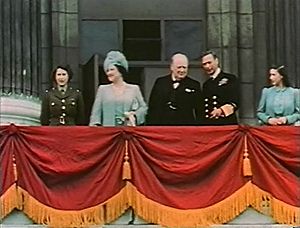
At the end of the war in 1945, Margaret appeared on the balcony at Buckingham Palace with her family and Prime Minister Winston Churchill. Afterward, both Elizabeth and Margaret joined the crowds outside the palace without being recognized.
In 1947, Margaret was confirmed into the Church of England. She also went on a state tour of Southern Africa with her parents and sister. This three-month trip was her first visit abroad. Margaret's chaperone was Peter Townsend, an aide to the King. Later that year, Margaret was a bridesmaid at Elizabeth's wedding. In the next three years, Elizabeth had two children, Charles and Anne. Their births moved Margaret further down the line of succession.
In 1950, the former royal governess, Marion Crawford, published a book about Elizabeth's and Margaret's childhood. It was called The Little Princesses.
The Margaret Set
Around 1947, the press began to follow Margaret's social life. She was known for being lively and witty. Margaret was a beautiful young woman with "vivid blue eyes." She enjoyed spending time with high society and young aristocrats. These friends became known as the "Margaret Set." Margaret was often in the news for her glamour and fashion sense.
Her official duties increased, including tours of Italy, Switzerland, and France. She also joined many charities as president or patron. The Margaret Set often went to popular clubs and restaurants. The press often guessed about her engagements or romances. In 1948, there were rumors of her engagement to the Marquess of Blandford. Similar rumors followed other friends. The set also mixed with celebrities like Danny Kaye.
Press interest could be very strong. In 1951, during a private visit to Paris, Margaret was followed by a photographer. British detectives had to remove him from the club. By the mid-1950s, many members of the "Margaret Set" were getting married. As Margaret reached her late twenties unmarried, the press wondered if she would remain single.
Public Interest in Her Relationships
The press often discussed Margaret's relationships. She was called "the world's most eligible bachelor-girl." Over 30 bachelors were linked to her. Most of these men had titles and were wealthy. Her family reportedly hoped she would marry Lord Dalkeith, but Margaret was not interested in outdoor activities like him. Billy Wallace, a wealthy old friend, was often her date in the mid-1950s.
During her 21st birthday party in 1951, the press was disappointed to only photograph Margaret with Peter Townsend. He was always in the background of royal pictures. To her parents, he was a safe companion as Elizabeth's duties grew. In September 1951, her father had surgery for lung cancer. Margaret was appointed a Counsellor of State. This meant she took on the King's official duties while he was ill. Her father died five months later, on 6 February 1952. Her sister became Queen.
Relationship with Peter Townsend
Early Connection
During the war, the King chose palace aides from the military. The princesses met Townsend, the new equerry, in 1944. Elizabeth reportedly told her 13-year-old sister, "Bad luck, he's married." Townsend's temporary job became permanent. The King and Queen liked Townsend. The King saw him as the son he never had.
Townsend was often near Margaret. When their relationship began is not clear. The princess told friends she fell in love with him during the 1947 South Africa tour. They often went riding together. In November 1948, they attended an event in the Netherlands. Townsend later said there was an attraction between them then, but they never spoke about it. Their friendship seemed to grow stronger in late 1950. This was when Townsend became Deputy Master of the Household.
By spring 1951, many noticed their growing romantic connection. Townsend said his love for her began in Balmoral in 1951. He and his wife separated in 1951.
Margaret was very sad after her father's death. She found comfort in her Christian faith. She returned to public duties in June 1952. American newspapers noted her new energy and guessed she was in love. With the Queen Mother, Margaret moved into Clarence House in May 1953. Her sister, the Queen, moved into Buckingham Palace. After the King's death, Townsend became Comptroller of the Queen Mother's household.
In June 1952, the Townsends hosted Queen Elizabeth II, Prince Philip, and Princess Margaret at a party. It is thought Margaret and Townsend's romance began around this time. Rumors that they wanted to marry started in August 1952. Townsend's divorce was finalized in December 1952. After this, rumors about him and Margaret spread more widely. Their shared sadness over the King's death likely brought them closer. They spent time together privately at Clarence House.
Marriage Proposal and Public Reaction
Townsend asked Margaret to marry him shortly before Christmas 1952. Margaret accepted and told her sister, the Queen. The Queen's permission was needed by the Royal Marriages Act 1772. The Church of England did not allow remarriage for divorced people. The Queen asked Margaret to wait a year and keep the relationship secret until after her coronation.
Foreign media discussed Margaret and Townsend's relationship, but the British press did not at first. After reporters saw Margaret remove fluff from Townsend's coat during the coronation on 2 June 1953, the British press began to report on it. The People newspaper first mentioned the relationship in Britain on 14 June. It warned about "scandalous rumours" but said they were "utterly untrue."
The proposed marriage caused a public discussion about royal rules. The Queen was advised to send Townsend abroad, but she refused. Instead, she moved him to her own household. Prime Minister Churchill approved of the match. However, his cabinet did not approve. The Archbishop of Canterbury also did not approve of Margaret marrying a man who had been married before. Opponents said the marriage would harm the monarchy.
Churchill discussed the marriage with leaders from the Commonwealth countries. They also opposed the marriage. Churchill told the Queen that Parliament would not approve a marriage that the Church of England did not recognize. This would happen unless Margaret gave up her rights to the throne.
Prince Philip was reportedly against Townsend. Margaret's mother and sister wanted her to be happy but could not approve the marriage. Besides Townsend's past marriage, there were financial and constitutional issues. Margaret would need money from Parliament if she married. It would be difficult to get Parliament's approval for the marriage.
The Queen told the couple to wait until 1955, when Margaret would be 25. At that age, Margaret would not need Elizabeth's permission under the 1772 Act. She could marry after telling the Privy Council of the United Kingdom, if Parliament did not stop her. Churchill arranged for Townsend to be sent to the British Embassy in Brussels. He left on 15 July 1953.
Media Attention and Decision
For two years, the press continued to guess about their relationship. In Brussels, Townsend said, "The word must come from somebody else." He avoided parties. Margaret was told by the Church that she could not receive communion if she married a divorced man. Some newspaper polls showed public support for Margaret's choice.
The couple could still communicate by mail and phone. Margaret worked on charity plays with friends. She also publicly dated other men. In January 1955, she made the first of many trips to the Caribbean. Townsend secretly traveled to Britain to see her.
In spring 1955, Townsend spoke to the press for the first time. He said he was "sick of being made to hide." He believed his exile would end soon. He thought their love was strong and the British people would support their marriage.
The press described Margaret's 25th birthday, 21 August 1955, as the day she was free to marry. They expected an announcement about Townsend soon. Hundreds of journalists waited outside Balmoral. A Gallup poll found that 59% of Britons approved of their marriage. People in London shouted "Go on, Marg, do what you want" at the princess.
"Nothing much else than Princess Margaret's affairs is being talked of in this country," The Manchester Guardian said. Buckingham Palace asked the press to respect Margaret's privacy. This was the first time the palace spoke about her personal life. People thought it meant an engagement was coming.
Why an engagement did not happen is unclear. Margaret may have been unsure if she truly wanted to marry him. She wrote to Prime Minister Anthony Eden that she needed to see him to decide. An important newspaper editorial on 26 October stated that the Queen's sister marrying a divorced man would disqualify her from her royal role. This convinced many that the princess might defy the Church and royal standards.
Townsend later wrote that Margaret "could have married me only if she had been prepared to give up everything." This included her position and money. He felt he was not important enough to balance what she would lose. Some historians believe their love had faded after two years apart.
Papers released in 2004 show that the Queen and Prime Minister Eden planned to change the 1772 Act. Margaret would have been able to marry Townsend by removing her and any children from the marriage from the line of succession. This would mean the Queen's permission would not be needed. Margaret would keep her royal title and allowance, stay in the country, and continue her public duties. Eden said the Queen did not want to stop her sister's happiness.
Three days after this plan was drafted, Margaret announced on 31 October 1955 that she would not marry Townsend. The decision was made on the 24th. It is not clear what she was told about the proposals before her decision.
End of the Relationship
Margaret later said she was "thoroughly drained, thoroughly demoralized." She and Townsend wrote the statement together. It was the first official confirmation of their relationship. Some Britons were angry or disbelieving. Others, including clergy, were proud of the princess for choosing duty and faith.
Townsend recalled, "We had reached the end of the road, our feelings for one another were unchanged, but they had incurred for us a burden so great that we decided together to lay it down." The Associated Press said Margaret's statement was almost "a rededication of her life to the duties of royalty." This made any future marriage for her seem unlikely.
After leaving the RAF, Townsend traveled the world. He and Margaret met several times after he returned in 1958. However, they could not avoid the press or royal disapproval. Townsend left Britain again to write a book. He said in 1970 that he and Margaret did not write to each other. Their love letters are in the Royal Archives and will be available to the public in 2030.
In 1959, Margaret wrote to Townsend after he told her he planned to remarry. She accused him of breaking their promise not to marry anyone else. She asked him to destroy her love letters. He claimed he did, but kept her last letter. Margaret had also broken the pact by getting engaged to Billy Wallace, though this was not known publicly until much later.
In 1993, a friend of Margaret revealed she had met Townsend one last time before his death in 1995. She said he looked "exactly the same, except he had grey hair." Guests said they chatted like old friends.
Marriage to Antony Armstrong-Jones

Billy Wallace later said that his relationship with Townsend was "a girlish nonsense." Margaret accepted one of Wallace's many marriage proposals in 1956. But the engagement ended before it was official when he admitted to another romance. Margaret did not reveal this publicly until 1977.
Margaret met the photographer Antony Armstrong-Jones in 1958. They became engaged in October 1959. Armstrong-Jones proposed with a ruby ring shaped like a rosebud. She reportedly accepted his proposal a day after learning Townsend planned to marry someone else. Margaret's engagement announcement on 26 February 1960 surprised the press. She had kept the romance secret.
Margaret married Armstrong-Jones at Westminster Abbey on 6 May 1960. It was the first royal wedding broadcast on television. It was watched by 300 million people worldwide. Margaret's wedding dress was designed by Norman Hartnell. She wore the Poltimore tiara. Her niece, Princess Anne, was one of her eight bridesmaids. The Archbishop of Canterbury conducted the service. After the ceremony, the couple appeared on the balcony of Buckingham Palace. Their honeymoon was a six-week cruise on the royal yacht Britannia. As a wedding gift, Colin Tennant gave her land on his private Caribbean island, Mustique. The newlyweds moved into Kensington Palace.
In 1961, Margaret's husband was made Earl of Snowdon. They had two children: David, born in 1961, and Sarah, born in 1964. Their marriage brought new friends into Margaret's social circle, including artists and celebrities. At the time, it was seen as a sign of British class barriers breaking down. The Snowdons experimented with the styles of the 1960s.
Separation and Divorce
By the early 1970s, the Snowdons had grown apart. On 19 March 1976, they publicly announced their separation. Their divorce was finalized on 11 July 1978. It was the first divorce of a senior member of the British royal family since 1901. Snowdon later remarried, but he and Margaret remained close friends.
Public Life and Charity Work

One of Margaret's first official duties was launching the ocean liner Edinburgh Castle in Belfast in 1947. She later went on many tours. Her first major tour was with her parents and sister to South Africa in 1947. Her tour to the British colonies in the Caribbean in 1955 was very popular. Calypsos were even written for her.
As British colonies became independent nations, Princess Margaret represented the Crown. She attended independence ceremonies in Jamaica in 1962 and Tuvalu and Dominica in 1978. Other overseas tours included East Africa and Mauritius in 1956, the United States in 1965, Japan in 1969 and 1979, Australia in 1975, and China in 1987.
In August 1979, Louis Mountbatten, 1st Earl Mountbatten of Burma, a relative, was killed by a bomb. That October, Margaret was on a fundraising tour in the United States. She told people that the royal family was touched by letters of sympathy from Ireland. A newspaper later claimed Margaret had called the Irish "pigs." Margaret and others denied this, but the damage was done. The rest of her tour faced protests.
Charity Work
Margaret was very interested in charities for welfare, music, and ballet. She was president of the National Society for the Prevention of Cruelty to Children (NSPCC) and the Royal Scottish Society for the Prevention of Cruelty to Children. She was also Grand President of the St John Ambulance Brigade.
She was president or patron of many other groups. These included the West Indies Olympic Association, the Girl Guides, and several ballet companies. She also supported the Royal College of Nursing and an AIDS charity. Margaret helped raise money for Dame Margot Fonteyn, a famous ballerina. She also organized yearly fundraisers for the NSPCC. Sometimes, Margaret was criticized for not being as active as other members of the royal family.
Later Life and Death
Margaret's later life was affected by illness. She had a lung operation in 1985. In January 1993, she was hospitalized for pneumonia. She had a mild stroke in February 1998. The next year, she badly scalded her feet in a bathroom accident. This affected her ability to walk, and she sometimes used a wheelchair. She was hospitalized again in January 2001 after another stroke. By March 2001, strokes had left her with partial vision and paralysis on her left side. Margaret's last public appearances were at her mother's 101st birthday in August 2001 and her aunt's 100th birthday in December.
Princess Margaret died in the King Edward VII's Hospital, London, on 9 February 2002. She was 71 years old. This was three days after the 50th anniversary of her father's death. The day before, she had suffered another stroke, followed by heart problems. Her nephew, Charles, then Prince of Wales, spoke about his aunt on television. Leaders from the UK and other countries sent their condolences.
Margaret's coffin was taken from Kensington Palace to St James's Palace before her funeral. Her funeral was held on 15 February 2002. This was the 50th anniversary of her father's funeral. As she wished, the ceremony was a private service for family and friends at St George's Chapel, Windsor Castle. Unlike most other royals, Princess Margaret was cremated. Her ashes were later moved to the King George VI Memorial Chapel in St. George's, after her mother's funeral in April 2002. A public memorial service was held at Westminster Abbey on 19 April 2002. Another service was held in 2012 to mark the 10th anniversary of her and her mother's deaths.
Legacy and Style
Public Image
People often described Margaret as a strong-willed person. She could be very charming and informal. Those who met her were sometimes confused by her changes between lightheartedness and formality. Her former governess, Marion Crawford, wrote that Margaret's "impulsive and bright remarks" often became headlines. These headlines sometimes made her seem like a different person than she was.
Gore Vidal, an American writer, said Margaret was "far too intelligent for her station in life." He remembered a conversation where she said that with two sisters, one must be the Queen, who is seen as good, while the other must be the "evil sister."
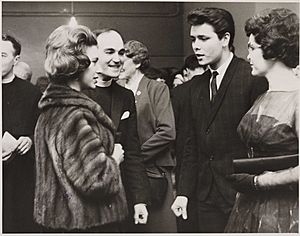
As a child, Margaret liked pony shows. But as an adult, she was not interested in hunting or fishing like other family members. She loved ballet from a young age and enjoyed acting in amateur plays. She even directed a play called The Frogs with her friends. Actors and movie stars often visited her home at Kensington Palace. In 1981, she was a guest on the BBC Radio 4 show Desert Island Discs. She chose Pyotr Ilyich Tchaikovsky’s Swan Lake as her favorite music. In 1984, she appeared as herself in a radio drama, becoming the first royal to do so.
Princess Margaret's private life was often discussed by the media. Her house on Mustique, designed by her husband's uncle, was her favorite holiday spot.
After Margaret's death, her lady-in-waiting, Lady Glenconner, said Margaret "was devoted to the Queen and tremendously supportive of her." Another cousin, Lord Lichfield, said Margaret was "pretty sad towards the end of her life because it was a life unfulfilled."
Many believe that Margaret's life, especially her challenges with marriage, helped change how the public viewed divorce within the royal family. Her experiences may have made it easier for her sister's children, three of whom later divorced.
Fashion and Style
Princess Margaret was seen as a fashion icon during her lifetime. Her style was called 'The Margaret Look'. She was known as a 'royal rebel' because her style was different from her sister's more traditional look. Margaret wore trendy mod accessories, like bright headscarves and glamorous sunglasses. She had a close relationship with the designer Christian Dior. She wore his designs often and was one of his most important customers. In 1950, he designed a cream dress for her 21st birthday, which is famous in fashion history.
Throughout the 1950s, she wore floral-print dresses, bold ballgowns, and luxurious fabrics. She accessorized with diamonds, pearls, and fur stoles. British Vogue said Margaret's style "hit her stride" in the mid-1960s. She was photographed with celebrities like The Beatles and Sophia Loren. Princess Margaret was also known for her "magnificent" hats and headdresses. Marie Claire stated that the princess "refused to compromise" on her style later in life.
In April 2007, an exhibition called Princess Line – The Fashion Legacy of Princess Margaret opened at Kensington Palace. It showed modern fashion inspired by her style.
Finances
Margaret's wealth was estimated to be around £20 million. Most of this came from her father. She also inherited art and antiques from Queen Mary. In 1999, her son sold her Caribbean home for about £2.4 million. At her death, Margaret received £219,000 a year from the government. She left £7.6 million to her two children, which was £4.5 million after taxes.
In June 2006, many of Margaret's belongings were sold at auction by Christie's. This was done to pay taxes and for her grandchildren's education. Some items were sold for charities. A Fabergé clock sold for a record price of £1.24 million. The Poltimore Tiara, which she wore at her wedding, sold for £926,400. The total from the sale was £13,658,000.
Titles, Styles, and Honours
Titles and Styles
- 21 August 1930 – 11 December 1936: Her Royal Highness Princess Margaret Rose of York
- 11 December 1936 – 6 October 1961: Her Royal Highness The Princess Margaret
- 6 October 1961 – 9 February 2002: Her Royal Highness The Princess Margaret, Countess of Snowdon
Honours
- Companion of the Order of the Crown of India, CI 12 June 1947
- Dame of Justice of the Order of St John of Jerusalem, DJStJ 23 June 1948
- Dame Grand Cross of the Royal Victorian Order, GCVO 1 June 1953
- Dame Grand Cross of the Order of St John of Jerusalem, GCStJ 20 June 1956
- Royal Victorian Chain, 21 August 1990
- Royal Family Order of King George V
- Royal Family Order of King George VI
- Royal Family Order of Queen Elizabeth II
Foreign Honours
 Netherlands: Grand Cross of the Order of the Netherlands Lion, 1948
Netherlands: Grand Cross of the Order of the Netherlands Lion, 1948 Zanzibar: Order of the Brilliant Star of Zanzibar, First Class, 1956
Zanzibar: Order of the Brilliant Star of Zanzibar, First Class, 1956 Belgium: Grand Cross of the Order of the Crown, 1960
Belgium: Grand Cross of the Order of the Crown, 1960 Uganda: Order of the Crown, Lion, and Spear of Toro Kingdom, 1965
Uganda: Order of the Crown, Lion, and Spear of Toro Kingdom, 1965 Japan: Order of the Precious Crown, First Class, 5 October 1971
Japan: Order of the Precious Crown, First Class, 5 October 1971
Honorary Military Appointments
 Colonel-in-Chief of the Bermuda Regiment
Colonel-in-Chief of the Bermuda Regiment
 Colonel-in-Chief of the Royal Highland Fusiliers of Canada
Colonel-in-Chief of the Royal Highland Fusiliers of Canada Colonel-in-Chief of the Princess Louise Fusiliers
Colonel-in-Chief of the Princess Louise Fusiliers Colonel-in-Chief of the Royal Newfoundland Regiment
Colonel-in-Chief of the Royal Newfoundland Regiment
 Colonel-in-Chief of the 15th/19th The King's Royal Hussars
Colonel-in-Chief of the 15th/19th The King's Royal Hussars Colonel-in-Chief of the Light Dragoons
Colonel-in-Chief of the Light Dragoons Colonel-in-Chief of the Royal Highland Fusiliers (Princess Margaret's Own Glasgow and Ayrshire Regiment)
Colonel-in-Chief of the Royal Highland Fusiliers (Princess Margaret's Own Glasgow and Ayrshire Regiment) Colonel-in-Chief of the Queen Alexandra's Royal Army Nursing Corps
Colonel-in-Chief of the Queen Alexandra's Royal Army Nursing Corps Deputy Colonel-in-Chief of the Royal Anglian Regiment
Deputy Colonel-in-Chief of the Royal Anglian Regiment Honorary Air Commodore, Royal Air Force Coningsby
Honorary Air Commodore, Royal Air Force Coningsby
Awards
- Queen Elizabeth II Coronation Award, 2003
Arms
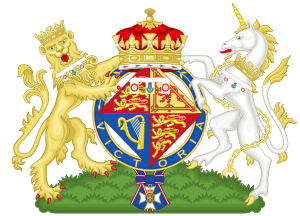 |
|
Children
| Name | Birth | Marriage | Children | |
|---|---|---|---|---|
| David Armstrong-Jones, 2nd Earl of Snowdon | 3 November 1961 | 8 October 1993 Separated 2020 |
Serena Stanhope | Charles Armstrong-Jones, Viscount Linley Lady Margarita Armstrong-Jones |
| Lady Sarah Armstrong-Jones | 1 May 1964 | 14 July 1994 | Daniel Chatto | Samuel Chatto Arthur Chatto |
Images for kids
-
Elizabeth and Margaret performing at Windsor Castle in a 1943 production of the pantomime Aladdin
See also
 In Spanish: Margarita del Reino Unido para niños
In Spanish: Margarita del Reino Unido para niños


